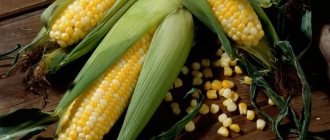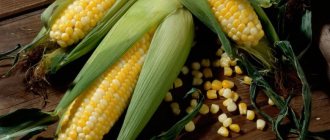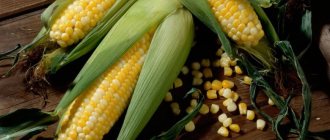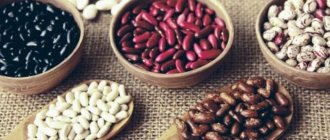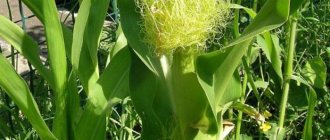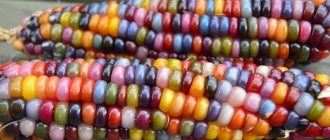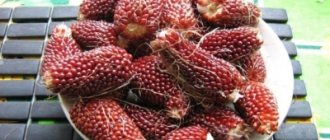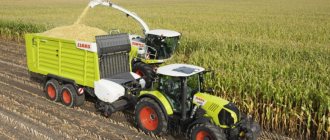Everyone knows corn. Whether fresh or canned, it is in demand in any form. And we love corn sticks and popcorn from early childhood. Accustomed to cobs with golden grains, many are not even aware of the variety of varieties of this crop. Not to mention where it came from and how long ago. Let's figure out what corn is, what family of plants it belongs to, and where it came from?
What is corn
Corn is a herbaceous plant with a developed root system and can reach up to 4 m in height. Scientists believe that this is one of the most ancient grain plants.
Fruit, vegetable, grain or legume?
To understand what corn is - a vegetable, fruit, cereal or bean, it is necessary to understand in detail what exactly is meant by all these concepts.
Vegetable is a culinary term for the edible part of plants. These can be leaves like lettuce, stems (celery), roots (beets) and flowers (cauliflower). The main thing is that these parts do not have seeds.
Fruit is an edible fruit. Serves for the formation, protection and distribution of seeds contained in it.
Cereals belong to the class of monocotyledonous plants that have a number of characteristic features:
- fibrous root system;
- long and narrow leaves;
- small, inconspicuous flowers collected in a spike;
- fruit of the grain.
Beans (legumes) are dicotyledonous plants with common features such as:
- taproot system;
- bilateral (rather than radial) symmetry of the flower;
- bean fruit (dry, usually multi-seeded, with two valves that open after ripening; seeds grow on these valves).
From the point of view of consumption, corn can be considered a fruit, since its grains are used for this purpose. In terms of appearance, corn belongs to the cereal family.
The role of corn in agriculture
This cereal is grown in huge quantities in the USA, Mexico, China, Brazil, Argentina and many other countries. Maize is very popular all over the world.
Growing corn on an industrial scale
It is not only a valuable grain crop, but also an excellent animal feed. All parts of the plant are used in the production of livestock feed.
Grains are actively used in the food industry; they are used to produce cereals, flour, delicate starch, molasses and even alcohol. Perfectly consumed fresh, boiled, baked, canned.
Did you know? Among cereals in the global agricultural economy, this crop ranks third in terms of cultivation volumes.
Biological description
Sweet corn, otherwise known as maize (lat. Zea mays) is a herbaceous annual cultivated plant that belongs to the genus Corn of the Cereals family.
The root system is fibrous, well developed, going 1-1.5 m deep. Aerial roots are formed in the lower part of the stem, which additionally nourish the plant and help prevent lodging.
The stem is erect, knotty, up to 4 m high and up to 7 cm in diameter. The internal cavity is filled with a loose substance, parenchyma. The leaves are large, straight, can reach 1 m in length and up to 10 cm in width. The venation is parallel. The bases of the leaves are tubes that enclose the stem, the so-called sheaths.
The flowers are unisexual, located on the same plant. The female ones are collected in cobs, surrounded by wrappers like leaves. A bunch of long pistils emerge from the top of the involucre, to which the wind carries pollen from the male flowers located in panicles at the top of the stem. This is how fertilization occurs and fruits are formed.
The shape of the fruits (kernels) is unusual for cereals. They are round or cubic. They are arranged in dense rows on the cob. Sizes, shape, color may vary among different varieties.
Terms and rules for planting corn
Corn is a heat-loving plant. The seeds are planted when the soil at a depth of six to eight centimeters warms up to ten degrees Celsius. This period falls on the second ten days of May.
Landing Features:
- The planting pattern for corn grains is 70x70 centimeters. If the plantings are dense, the seedlings are thinned after the second leaf appears. Planting density will lead to a lack of light, and as a result, to pale leaves and thinning of the plant stem.
- Plant the corn grains to a depth of five to six centimeters. It is important that the seeds get into the moist layer. Therefore, it is possible to place them at a depth of eight centimeters.
In the fields, after sowing corn, the soil is rolled, which avoids drying out the soil. If it rains during the planting period, then you should not roll the area. On the fourth or fifth day after precipitation, it is necessary to loosen the top layer, removing the crust and destroying weed shoots. In this case, the harrowing depth should be insignificant.
You can also use the seedling method for growing cereals. Seedlings are planted in open ground at thirty days of age. Each variety of corn has its own planting time, but soil temperature plays an important role in seed germination.
Brief history of origin
Based on studies of starch microparticles from grains and fossil plants, American scientists have determined that corn (more precisely, its wild ancestor teosinte) was domesticated about 8,700 years ago in southern Mexico. Ancient corn cobs were no more than 3-4 cm in length.
From the 15th century BC. maize began to spread throughout Mesoamerica. New growing conditions led to an increase in the number of varieties in the 12th-11th centuries BC.
The ancient Mayans grew different varieties of corn, differing in cob size, yield, and ripening time. Maize had the status of a sacred plant for the Indians. The Aztec religious system included the god of corn, Centeotl.
In the 15th century, corn was brought to Europe by Columbus. The Russians learned about corn during the Russian-Turkish wars for Crimea.
How to choose the “right” cob
It is best to eat young corn - its grains are milky yellow. It contains more nutritional components and is easier to digest.
The leaves should fit tightly to the cob and have a fresh appearance. It is better not to buy refined cereal, because it quickly dries out and spoils.
Regular consumption of small amounts of this cereal has a beneficial effect on the body and helps get rid of some problems.
It can be eaten by both adults and children. But in everything you need to observe moderation. Overeating puts additional stress on the gastrointestinal tract and complicates digestion.
Etymology
The Latin word Zea has Greek roots. This was the name of one of the varieties of wheat widespread in the Bronze and Middle Ages in Europe. In most European languages, the plant retained its Indian name maize. It has common roots with the word mahiz, which meant corn in the Taino Indian language.
In Russian the name corn is used. The origin of this word is associated with the existence in some Slavic languages of similar words with the meaning “curly”. According to another version, corn is a derivative of the Romanian cucuruz, which means “fir cone.” There is also an opinion that the Russian word corn is related to the Turkish kokoros (corn stalk).
Is corn oil good or bad?
Corn oil is used to prepare various dishes, and is also consumed internally in its pure form. It is a source of enzymes needed by the body.
Refined oil does not contain any specific odor or pesticides. Therefore, it is added to baked goods, foods are fried on it, and it is used to make sauces. This oil can be offered to young children. It is included in the diet of people who follow a diet menu.
Unrefined oil does not undergo special purification. Impurities remain in it. However, real benefits can only be obtained from such oil. It has a rich color and a characteristic aroma. This indicates that all vitamins have been preserved in the product. They will be lost during refining.
In order not to harm the body, unrefined oil should be stored in the freezer, in a dark container.
Unrefined oil contains high amounts of vitamin E, ubiquinone (Q10) and phytosterols, which increases its shelf life and makes it potentially effective in lowering cholesterol levels.
Kinds
The entire variety of corn varieties is divided into 9 botanical groups, which differ in the structure of the cob and the shape of the grain.
- Flintweed (Zea mays imdurata) is one of the most popular varieties. The plants are distinguished by a small number of leaves, powerful tall stems, and massive ears. The grains are round in shape, wrinkled, white or yellow in color, and consist of 70-80 solid starch. This corn is used to produce grain. It is used to produce flakes and sticks.
- Tooth-shaped (Zea mays indentata). This group includes late-ripening, productive varieties. The plants are sparsely leafy, have a strong stem and large ears. The grains are large, elongated, with a characteristic dent that makes the fruit look like a tooth. Dental corn is used as a raw material for cereals, flour, alcohol and as a fodder plant.
- Semi-dentate (Zea mays semidentata) was developed by crossing varieties of flint and tooth varieties. Sometimes found under the name semisiliceous. The plants are not bushy and are grown for silage and grain.
- Bursting (Zea mays everta). Plants of this group are bushy, with many leaves. During the ripening process, several small ears with small, even, glossy grains are formed. There are two subgroups of popping corn varieties: rice and pearl barley. Their names indicate the similarity of the taste of the grains with the corresponding cereals. The kernels pop when heated and are used to make popcorn.
- Sugar (Zea mays saccharata). Varieties of sweet corn are quite common. The plants are bushy, forming several ears with grains containing a large amount of sugars and a minimum of starch. Mainly used in the industrial production of canned corn.
- Starchy (Zea mays amylacea). The oldest group of varieties. Bushy plants with a large volume of foliage are cultivated only in South America and southern North America. The grains contain more than 80% starch. Starch, molasses, flour, and alcohol are obtained from these varieties.
- Starchy-sugar (Zea mays amyleosaccharata). Grains consist of a mealy substance. Plants of this group are not of agricultural interest.
- Waxy (Zea mays ceratina). The waxy variety group is most common in China. The grain consists of two layers of tissue: an outer hard, wax-like part and a mealy middle layer.
- Membranous (Zea mays tunicata). Plants of the group do not have a wide variety of varieties. The taste of the grain is low. They are grown for their green mass, which is used as livestock feed.
Varieties
Maize has many subspecies. Among them are field and domestic plants, which differ slightly in grain color, cob ripening, yield and use.
Waxy
This is a hybrid that was obtained by crossing three varieties at once: toothed, North American and bursting Chinese. Corn gets its name from the fact that the endosperm is surrounded by a double layer of tissue. The first is solid, its structure resembles wax. The second is the mealy layer, which gives the cob a whitish tint. Grains can be of different colors and shapes. Productivity is low, so this species is practically not grown in our country. The supplier is China. Only there does waxy corn receive the germination conditions necessary for its growth.
See also: The best varieties and hybrids of sweet corn - rules of cultivation and care
Dentoform
Late ripening variety. It is distinguished by the bright yellow color of the grains, which are large in size and have an elongated shape. It is very popular in Russia. When young, it is boiled and frozen. Flour and cereals are made from overripe ones and given as animal feed. Knuckle corn is renowned for its high yield and large amount of silage after harvest. In ripened grains, a depression is formed at the top, which contains about 74-75% starch, 10% proteins and 4-5% fats. The variety is characterized by increased glassiness.
Starchy (mealy, soft)
It is grown mainly only in America. The plant grows more than two meters in height. It ripens late, but produces a lot of green mass, which is used for animal feed. The cobs are thin and long (about 30 cm). The grains are round, but strongly flattened. They have a smooth, non-shiny surface. The color is mainly white or yellow. A special feature of this variety is its high content of soft starch (more than 80%). Due to this, mealy corn is used to make molasses and flour.
Siliceous (Indian)
Although this variety does not produce a high yield, it has many other advantages. For example, resistance to frost and grain shedding, immunity to diseases that threaten shoots. Indian corn is not afraid of powdery mildew, rot and fungi. The stem is tall and strong, there are few leaves, the ears are massive. The grains are round, convex and have a smooth shiny surface. Contain up to 85% starch, 4% fats and 15-16% proteins. Sweet sticks and flakes are made from this variety.
Bursting
This is an ancient type of maize with many leaves and small ears, the grains of which are small and glossy. They contain a lot of protein - more than 16%, and fat - about 20%. There are two subgroups of popping corn: pearl barley and rice. The structure of the grain is solid, but when heated due to the evaporation of water, the shell of each grain breaks and they burst. The color of the cobs can be very diverse. The most common colors are blue, red, white and yellow.
Membranous
A less common type of crop. It has low palatability, but due to its abundant foliage this variety is grown for cattle feed. The cobs are not much different in shape and color from other varieties. But the main feature is the scales that cover the grains.
Cultivation
Corn is widely cultivated in all arable regions of the world. The plant is light-loving and heat-loving, although quite resistant to frost.
For cultivation in the country, choose dry, open areas with loose, well-fertilized soil. It is better to grow corn from seeds in areas with a warm climate. Corn seeds are planted in late April-early May. In the northern regions, it is recommended to use the seedling method. Planting in the ground with this method is carried out in early June.
Throughout the entire growing season, especially when the cobs are ripening, plants must be watered on time and abundantly. To obtain full ears during the flowering period, it is recommended to carry out 2-3 pollinations by shaking the flower panicles.
The harvest is harvested a month after flowering; during this period the grain reaches milky ripeness.
Grain storage and transportation
When storing, it is critical to consider the moisture content of the corn and environmental conditions, the air temperature in the storage, and the degree of aeration. Today, two main modes are used:
- storage of dry grain, the moisture content of which is previously reduced to critical in special drying machines;
- storing refrigerated products at temperatures that stop vital processes in living grain.
Delivery of corn from the supplier to customers is carried out using road or rail transport in compliance with the required level of humidity and temperature.
Benefit
Corn is used in many areas of human activity. Maize is widely used as food and as a medicine in folk medicine. Modern technologies make it possible to obtain fabrics and plastics from it.
Food
Corn is a source of carbohydrates. The fruit contains about 15% protein, depending on the variety. It is a source of vitamins B, C, D, E, K, and folic acid.
Maize grains contain minerals: magnesium, potassium, calcium, iron, zinc, selenium. Cobs are rich in carotenoids. 100 g of grain contains half the required daily amount of dietary fiber. Corn and dishes based on it are gaining popularity due to the absence of gluten, one of the strongest allergens.
Medical
In folk medicine, corn takes pride of place. Almost all parts of the plant are used for medicinal purposes.
Tinctures of stigmas are used to improve the functioning of the gallbladder in case of cholecystitis, hepatitis and other liver diseases, and also as a diuretic and sugar-lowering agent.
Corn oil is a source of healthy Omega-3 fatty acids. Eating this oil reduces the level of “bad” cholesterol and prevents the occurrence of heart attacks and strokes.
Ecological
Due to its widespread availability and chemical composition, corn is used as a renewable raw material resource for the production of green plastics.
The fermentation of corn sugars produces polylactide (PLA), a biodegradable and biocompatible polymer material. It is used to make packaging for food products and is used in the production of surgical threads and pins.
Polylactide threads are used in the production of fabrics. Fabrics containing this polymer are easily dyed and combine the advantages of synthetic and natural fibers. At the same time, they do not harm the environment, because they are biodegradable.
Appearance in Europe and Russia
Corn arrived in Europe in 1496 thanks to Christopher Columbus . Farmers quickly appreciated the sun grass, ease of cultivation and wonderful taste. Maize began to be grown in the southern regions of Spain, France, and Portugal. But in northern European countries they could not grow the imported crop, since the heat-loving corn did not have time to ripen. Much later, new, more cold-resistant varieties appeared.
Maize cobs
Corn has not become as popular a grain as rye and wheat, but it occupies an honorable third place in the world in terms of cultivation volumes.
Good to know! The history of corn in Russia begins at the end of the 18th century after another war with Turkey in 1768-1774. Our country received the territory of Crimea as compensation. Just at that time, the Turks were actively growing kokoroza, which translated means “tall plant.” According to one version, the sound, which was not entirely convenient for the Slavs, gradually turned into corn.
Corn grows widely in Russia in the southern regions, the main part in the Stavropol and Krasnodar territories. However, it has not received mass distribution, as in America and Mexico, in our country.
Effect on the body
Due to the high content of vitamins, minerals, and amino acids, corn has a beneficial effect on all human organs.
Corn consumption:
- improves the functioning of the gastrointestinal tract;
- cleanses the body of toxins and waste;
- reduces cholesterol levels;
- has a beneficial effect on brain function;
- helps to lose excess weight;
- safe for diabetics and allergy sufferers.
People with increased blood clotting, prone to thrombosis and thrombophlebitis should treat maize with caution. You should not eat corn during an exacerbation of gastrointestinal ulcer disease.
What are the benefits of corn for proper nutrition?
Corn is useful not only for problems in the body. For its rich and balanced composition, it is valued by people who carefully monitor their diet. In a vegetarian menu, it can replace meat because it contains a large amount of protein.
Maximum benefit and minimum harm comes from eating raw corn. It retains the largest number of components, and young cobs are more easily absorbed by the body.
But most people prefer to use boiled corn to prepare various dishes.
What are the benefits of a diet that includes corn:
- normalization of digestion, cleansing the intestines and eliminating constipation;
- improving memory, concentration and mood;
- acceleration of metabolism and natural weight loss;
- strengthening the immune system.
People who are actively involved in sports should also pay attention to this product. Corn starch is involved in the formation of muscle fiber, and vitamins help restore strength after physical activity.
Corn flour is widely used in cooking. It gives baked goods a special airiness. Adherents of proper nutrition appreciate its composition, which is rich in proteins, carbohydrates, fiber, vitamins and minerals.
It replaces regular flour, which does not have so many positive qualities.
A wild type of corn, maize, is beneficial for the body and can form the basis of dietary nutrition. A wide variety of dishes are prepared from it, which not only taste great, but also improve health.
For pregnant
Many women who are in an interesting position want to enjoy this delicious cereal. You shouldn’t deny yourself this pleasure, because the product has a particularly beneficial effect on pregnant women:
- Reducing toxicosis. Grains cleanse the body and reduce toxic effects, so you can soon forget about nausea and other symptoms;
- Folic acid ensures normal fetal development. It is necessary for the proper formation of the nervous system and prevents the appearance of defects in the baby’s cardiovascular system;
- Promotes the production of sufficient milk during lactation. This is especially important for the baby, because together with mother’s milk he receives all the nutrients and antibodies that form the baby’s immunity;
- Reduces sensitivity to other foods, in particular to fried foods and fish;
- Cereal helps strengthen the cardiovascular system, which will help avoid problems during childbirth;
- Restoration of the body. Pregnancy takes a lot of energy. The development of the baby requires most of the vitamins and minerals found in the mother’s body. Calcium levels are especially severely reduced. The cereal will replenish losses and provide sufficient support to all organs.
Use is permissible at any time. However, it must be remembered that even the most useful product will have a negative effect if abused.
For children
Children love the bright yellow grains, so they don't need to be forced to eat this cereal. It provides the growing body with necessary substances, supports the immune system, normalizes the functioning of the nervous system and helps in muscle formation.
Silicon strengthens tooth enamel, and pectin and fiber improve intestinal function.
Corn porridge can be introduced into the diet from 8-9 months. It is recommended for children who have difficulty gaining weight and suffer from constipation. Boiled cereal is given from two to three years of age.
But in order for the baby to receive the maximum nutrients, he must chew the grains thoroughly.
In addition, corn starch is used to produce baby powder.
For weight loss
Many women believe that corn is harmful to their figure. But this is not so: if she replaces one of her meals, this will contribute to rapid weight loss.
Despite the rather high calorie content, maize has great nutritional value, so it provides a feeling of fullness for a long time.
In order not to want to eat for a long time, it is enough to eat 200-300 g of this product.
The components contained in its composition remove toxins and speed up metabolism. Therefore, within a couple of weeks after the start of regular use, the body feels light and weight decreases.
Another advantage is that the cereal can be eaten in any form. Boiled cobs, porridge or other dishes produce the same effect. A varied menu will not get boring for a long time, so sticking to the corn diet is quite simple.
Rules for selection and use
Corn appears on sale at the end of summer. Choose cobs wrapped in green leaves. The hairs should be fresh and shiny; light yellow grains have the best taste. Dark spots or mold are not allowed on the cob.
Milk-ripe corn can be stored for no more than 3 weeks when refrigerated. Boiled corn on the cob, wrapped in cling film, can be stored in the refrigerator for several days. Frozen boiled cobs will keep in the freezer for up to 3 months.
It is better to choose corn sticks and flakes without additives and consume them with low-fat fermented milk products. These products are only truly healthy if they are actually made from grains.
Possible harm and contraindications
Corn, in addition to its enormous benefits, can also be harmful to health. Especially if you eat it in large quantities. It is a moderate allergen, so it is not recommended for people prone to allergic reactions.
It is worth limiting the use of this product for the following diseases:
- gastritis and disruption of the fermentation process. Such gastrointestinal diseases make it difficult to digest heavy foods;
- high blood clotting and tendency to form blood clots. This cereal contains a lot of vitamin K, which further increases these indicators;
- low body weight. Maize reduces appetite, so its regular consumption prevents natural weight gain;
- ulcers and diseases of the duodenum. The use of this product causes increased gas formation, which causes additional problems.
Eating grains in reasonable quantities will help avoid possible problems with the body.
Interesting Facts
The plant is 12,000 years old.
During archaeological excavations in Mexico City, scientists discovered corn pollen that had been preserved for 55,000 years.
In past centuries, the plant had a short stature, the cob grew at the top of the cereal, and was decorated with a large panicle. Wind pollination caused seeds to spread across the ground. The plant is cultivated in all countries except Antarctica.
Corn, which became the basis of highly productive agriculture, played a key role in the development of all Mesoamerican civilizations, which was reflected in their religious system.
The gods and goddesses of corn - Centeotl among the Aztecs and Yum Kaash among the Mayans - were among the most revered in the pantheon. But other gods were also depicted with corn in their decorations or were involved in the mythical appearance of the cereal.
Thus, the supreme god of the Mayans and Toltecs, Quetzalcoatl, long and diligently searched for the best plant for cultivation until he found maize on the border of Guatemala and Mexico.
New mythology attributes the domestication of corn not to gods, but to aliens. And all because modern cultivated cereals can grow exclusively from seeds sown by humans.
A cob that just falls to the ground is highly likely to rot. And since the spread of culture is impossible without human intervention, how could it even appear in this world, if not with the help of aliens?
Scientists with archaeological finds in hand answer this question with a detailed description of the evolution of wild maize, which previously looked different, was pollinated differently, and produced its “legacy” without outside help.
And only ancient selection intervention deprived new cultivated species of this “independence”.
However, even after convincing explanations from scientists, maize gives enough reason to be surprised. Here are 10 interesting facts about him:
- An ear of corn always has an even number of grains (up to a thousand in one cob), usually located in 10-14 rows.
- The stem can grow up to 7 meters, which is comparable to the height of a two-story house.
- Corn is a dioecious plant, and alone it does not bear fruit, so in one field both male maize (with flowers in panicles on the tops of the shoots) and female maize (with flowers collected in the axils of the leaves) grow alternately.
- Ancient Mexican peoples used dried corn stalks to build homes and outbuildings.
- After separating the grain, the cobs are used as raw material for the production of smoking pipes.
- For lack of better material, cob wrappers were taken in Colombia to make balls.
- The effect of turning corn kernels into a popcorn balloon when heated was known to ancient American civilizations.
- The revival of the popularity of popcorn is directly related to the income system of cinemas, where the sale of popcorn has surpassed the profitability of the income from film rentals.
- Mexicans are considered the leaders in eating corn in various forms. One adult resident of the country accounts for approximately 90 kg of product per year. The Americans, who are in second place with 40 kg, are more than 2 times behind them.
- The Aztec corn god Centeotl aroused the envy of another deity with his popularity and was cut into many pieces, some of which turned into a plant. The Mexican name for corn retains an association with this legend. The word "tlaolli" from one of the indigenous languages of Mexico can be translated as "our meat (body)."
How to cook corn correctly in a saucepan - step-by-step recipe
When properly processed, boiled corn retains its valuable properties almost completely. Here's what you need to do to get a healthy snack:
- Select young fruits with grains that are milky white or yellowish in color.
- Peel them from the outer leaves, separate the corn silks with columns, cut off the remaining stalks and unripe tops.
- Wash under the tap.
- Place in a large saucepan. If it is too small, break the cobs in half. Don't add salt. It will make boiled corn firmer.
- Pour boiling water until it completely covers the contents.
- Bring to a boil.
- Cook for 15-20 minutes. Sometimes I forget and leave it to simmer longer. Increasing the cooking time to 30-40 minutes will not harm.
- Leave to cool. Do not remove the corn from the water. Really, it tastes much better.
Serve warm, sprinkled with salt (do not oversalt). Soviet cookbooks suggested flavoring it with a piece of butter. I think this is unnecessary.
You don’t have to remove the leaves completely, but leave 1-2 layers. This will not add any benefits or taste, but the presentation will be bright (if you are not afraid of the cloudy broth).
If you come across old corn, soak it for 2-3 hours and then cook it. It will take more time - up to 3-4 hours. Let it soak. Leave the cooked cobs to sit for several hours or until the next morning.
Corn: Is it a fruit, vegetable or grain and what family does it belong to?
Some people still argue about what type of plant corn is, despite the fact that botanists have now been able to characterize it quite accurately. What this plant is: corn, also known as maize, is a cereal, vegetable, bean or fruit, and where the debate about its classification came from will be discussed in this article.
Description
According to its characteristics, corn is largely a cereal crop. The flowering process, leaf structure, fruit ripening and appearance indicate a similar affiliation. However, unlike a typical cereal, the interior of the corn stalk does not consist of voids, but of a loose substance called parenchyma. This is understandable; reaching two or more meters in height with a hollow stem would be impossible.
With the root system, everything is also ambiguous, because it is more like the roots of a banana bush. And such a similarity is not surprising, since corn, like a banana, has to withstand the weight of difficult fruits. Therefore, again, the external characteristics of both the plant itself and its fruits take the yellow cob further away from the cereal family.
In any case, despite the difference in size and type of root systems, the stalk and leaves of corn are excellent as livestock feed, just like other grain crops.
Next, let's look at what the attempts to classify corn as vegetables, fruits or beans are based on. In fact, if we discard the botanical characteristics, then only a conditionally yellow cob can be attributed to one of the crops. This is explained by the fact that in the botanical definition there is no such thing as “fruit”.
From Latin fructus is translated as “fruit”. And botanists gave this word a precise definition, but if we generalize, it turns out that a fruit is a product obtained as a result of the ovary of a flower with its subsequent fertilization. That is, based on what is written, corn is on the same side as banana, tomato and beans.
Is corn a vegetable or a fruit? To answer the question, you will need knowledge of the biological description of the plant, its types and the structure of the tall annual. It is a mistake to consider it a vegetable, but it is not a fruit either. Yes, the juicy and sweet pulp contains a large number of microelements and useful substances, but botanists have long given a definite answer.
It is more correct to ask another question: is corn a juicy vegetable or a grain? The correct answer is, of course, cereal. Young grains on the cob are juicy and soft at first, but when ripe they become hard as glass. In appearance, the seeds resemble wheat or other types of cereals. Another reason for this answer is the structure of the plant, which clearly indicates that corn, by definition, cannot be a vegetable.
Vegetables are covered with a peel, inside of which there is pulp with seeds, and in cereals, the seeds sprout on ears and it is the seeds that are used for food.
What is corn
The healthy and tasty plant corn came to Russia from the American continent. It is on par with oats and rye in terms of fiber content and other useful substances, and tastes like wheat, although in appearance it belongs to other grain crops.
This is an annual, tall herbaceous plant, on the stem of which several rows with cobs are formed, the leaves of which protect the grains from pests, birds and atmospheric phenomena.
Some varieties can grow up to 3 m in height. Almost all parts of the plant are used for food and for the preparation of medicinal or cosmetic products.
What is corn
Corn comes from a genus of plants in the cereal family. The plant is tall, often the stem height exceeds 3-4 m, and due to this growth it has a well-developed root system located both underground and above it. Unlike other cereals, the stem is not hollow inside and reaches 7 cm in diameter.
The culture is divided into 9 large groups: siliceous, tooth-shaped, semi-tooth-shaped, bursting, sugar, starchy, starchy-sugar, waxy and filmy. They differ from each other in the type of grain structure, taste and cultivation characteristics.
So, according to the botanical definition, corn is still a grain and a fruit. After all, the cobs store the seeds with which corn reproduces. In this process, the fruit eventually separates from the plant to germinate.
However, if you look at the culinary definition, this crop is a vegetable. A fairly common misconception is that a vegetable is an unsweetened fruit that is used to prepare main dishes, and anything sweet is a fruit and should be served for dessert. It turns out that the complex grain crop corn is a vegetable, a cereal, and a fruit.
It should be mentioned that grain crops are in many ways similar to legumes and legumes. What they have in common is that they eat the succulent part of the plant. They can be processed into cereals or canned as a vegetable or fruit. Often this similarity confuses people, and they begin to urgently remember their school biology lessons in order to identify this cereal somewhere.
Effect on the body
If we consider the effect that corn has on the human body, then the first step is to characterize what vitamins and minerals are contained in its cobs.
Probably, not a single vegetable or fruit can compare with corn in terms of its range of nutrients and beneficial substances. A large amount of fiber, fats and essential oils has a beneficial effect on the gastrointestinal tract and helps remove toxins faster. A complex of vitamins A, C, PP, E and group B improves immunity and normalizes metabolism. The mineral composition in the form of magnesium, calcium, iron, phosphorus, manganese has a beneficial effect on the condition of the skin and hair, the functioning of the heart and blood vessels.
Corn grain (100 g) contains:
- carbohydrates - 67.5 g;
- protein - 10.3 g;
- fat - 4.9 g.
The calorie content of the product is from 88 to 325 kcal.
Of course, corn alone will not help cope with diseases, but if you include it in your diet, you can avoid many unpleasant diseases. This vegetable (or fruit) is recommended to be consumed both by those who are trying to lose weight and by those who, on the contrary, are gaining weight. The high amount of selenium in grains helps cope with premature skin aging. And in folk medicine, it and legumes are often used as a remedy for diarrhea and dysentery.
There's probably nothing that corn can't help with. Not as a panacea, of course, but as one of the auxiliary elements.
How to choose
So, we figured out what corn is - a cereal, a vegetable or a fruit. Now is the time to learn how to choose the right corn cobs so as not to make a mistake.
Most grain crops indicate their ripeness by the color of the grains. Ears at the stage of milky ripeness are light yellow in color and contain the most vitamins and minerals. The richer the color of the cob, the older the vegetable.
Between themselves, the cobs should be approximately the same size, covered with leaves. If there are no leaves, this means that the cereal was treated with chemicals, which caused the leaves to curl and no longer look attractive. You should not buy such cobs, since it is not known what kind of chemicals were used.
Corn in medicine
Various parts of corn are used in medicine. For example, columns with stigmas, which are collected when the cob is at the stage of milky ripeness, are used in the treatment of liver diseases or as a choleretic and diuretic. They contain large amounts of ascorbic acid, vitamin K, fatty oil, essential oils, saponins. Corn extract is used for cholangitis and cholecystitis. In case of emergency to stop bleeding.
Due to their high fatty oil content, grains and legumes are valued as an additional element of dietary nutrition for atherosclerosis, obesity and diabetes.
Corn grains and legumes in the form of puree soup are part of the diet for gastritis, having a positive effect on the gastric mucosa. However, legumes and corn grains are used not only in dietetics, but also in cosmetology as masks for the skin.
This excerpt from the program of the first TV channel “Life is great!” will tell you about corn: its benefits for the body, how to choose, how to store and how to cook.
Corn is a widely cultivated plant. In terms of consumption volumes in the world, only wheat and rice can compete with it. Mexicans are the record holders in corn consumption: one resident of this country eats about 100 kg per year. A familiar crop raises many questions: is corn a fruit or a vegetable, is it a legume or not, and where does it come from? You will learn about everything from our article.
What is corn
Corn is a herbaceous plant with a developed root system and can reach up to 4 m in height. Scientists believe that this is one of the most ancient grain plants.
To understand what corn is - a vegetable, fruit, cereal or bean, it is necessary to understand in detail what exactly is meant by all these concepts.
Vegetable is a culinary term for the edible part of plants. These can be leaves like lettuce, stems (celery), roots (beets) and flowers (cauliflower). The main thing is that these parts do not have seeds.
Fruit is an edible fruit. Serves for the formation, protection and distribution of seeds contained in it.
Cereals belong to the class of monocotyledonous plants that have a number of characteristic features:
- fibrous root system;
- long and narrow leaves;
- small, inconspicuous flowers collected in a spike;
- fruit of the grain.

